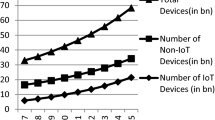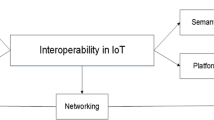Abstract
Lightweight data formatting and document exchanging schemes are of interest in conserving energy while exchanging documents, particularly in the resource constrained networks (RCNs). This paper presents an energy-conserving, lightweight method for data representation and trusted document exchange. It is based on a format derived from the YAML Ain’t Markup Language (YAML), a lightweight data serialization language and includes a schema extraction process to separate data from its structure. The resultant schema is useful for thinning the data format and also for checking the rewriting attacks. The rewriting attack is checked using a two-tiered approach. It is observed that the proposed document format is less verbose and more energy conserving than XML and other popular non-binary formats. The format can be used to represent non-document data also.
Similar content being viewed by others
References
Li H (2000) XML and industrial standards for electronic commerce. Knowl Inform Syst 2(4): 487–497
Hanslo WS, MacGregor KJ (2003) Using XML messaging for wireless middleware communication. In: Proceedings of the South African telecommunication network & applications conference, (SATNAC ’03), Southern African telecommunication networks and applications conference, Southern Cape, South Africa, September 2003. North-Holland Publishing Co
Kangasharju J, Lindholm T, Tarkoma S (2007) XML messaging for mobile devices: from requirements to implementation. Int J Comput Telecommun Netw 51(16): 4634–4654
Lee H-H, Lee W-S (2010) Consistent collective evaluation of multiple continuous queries for filtering heterogeneous data streams. Knowl Inform Syst 22(2): 185–210
Ng W, Lam W-Y, Wood PT, Levene M (2005) XCQ: a queriable XML compression system. Knowl Inform Syst 4: 421–452
Gupta M, Tu M, Khan L, Bastani F, Yen I-L (2005) A study of the model and algorithms for handling location-dependent continuous queries. Knowl Inform Syst 8: 414–437
Michael MP (2005) Energy awareness for mobile devices. In: Research seminar on energy awareness. University of Helsinki
Potlapally N, Ravi S, Raghunathan A, Niraj K (2006) Heterogeneous grid computing for energy constrained mobile device. IEEE Trans Mobile Comput 5: 128–143
Gu GQ, Lu J-Z (2008) Some issues of computer networks: architecture and key technologies. J Comput Sci Technol 21(5): 708–722
Artail H, Shihab M, Safa H (2009) A distributed mobile database implementation on pocket PC mobile devices communicating over Bluetooth. J Netw Comput Appl 32(1): 96–115
Orthogonal frequency-division multiplexing. Available at http://en.wikipedia.org/wiki/OFDM/
Lai Y-X, Chen Y-L, Chen H (2008) PEJA: progressive energy-efficient join processing for sensor networks. J Comput Sci Technol 6(6): 957–972
Kangasharju J, Lindholm T, Tarkoma S (2008) XML security with binary XML for mobile web services. Int J Web Serv Res 5(3): 1–19
Botia JA, Gomez-Skarmeta AF, Doung HH, Demeure I (2010) A context-sware data sharing service over MANet to enable spontaneous collaboration. In: Proceedings of the IEEE workshop on enabling technologies: infrastructure for collaborative enterprises (WETICE ’08), 17th workshop on enabling technologies: infrastructure for collaborative enterprises. IEEE Computer Society, Washington, DC, USA, pp 159–164
Blaya JAB, Demeure I, Gianrossi P, Lopez PG, Navarro JAM, Meyer EM, Pelliccione P, Tastet-Cherel F (2009) POPEYE: providing collaborative services for ad hoc and spontaneous communities. Service oriented computing and applications, vol 3, no 1. Springer, London, pp 25–45
Leite B, Bezerra D, de Assis F, de Carvalho T (2010) Symbolic data analysis tools for recommendation systems. Knowl Inform Syst 26(3): 385–418
Mrida D, Baldiris S, Fabregat R, Velez J, Huerva D (2007) A user model that incorporates characteristics of access devices in MAS-SHAAD. In: Proceedings of the TUMAS-A workshop (UM 2007), 11th international conference on user modeling, Corf, Greece, pp 51–55
Rosaci D, Sarné GML, Garruzzo S (2009) MUADDIB: a distributed recommender system supporting device adaptivity. ACM Trans Inform Syst 27: 1–41
Mrida D, Fabregat R, Prat X, Huerva D, Velez J (2008) A dynamic content generator for adaptation in hypermedia systems. Lecture notes in computer science, vol 5149. Springer, Berlin, pp 320–323
Göksedef M, Şule G-O (2010) A dynamic content generator for adaptation in hypermedia systems. Lecture notes in computer science, vol 37, no 4. Pergamon Press Inc, pp 2911–2922
Rosaci D, Sarn GML (2006) MASHA: a multi-agent system handling user and device adaptivity of Web sites. User modeling and user-adapted interaction, vol 16, no 5. Springer, the Netherlands, pp 435–462
Malandrino D, Mazzoni F, Riboni D, Bettini C, Colajanni M, Scarano V (2009) MIMOSA: context-aware adaptation for ubiquitous web access. Person Ubiq Comput 14(4): 301–320
Beach A, Gartrell M, Xing X, Han R, Lv Q, Mishra S, Seada K (2010) A context-sware data sharing service over MANet to enable spontaneous collaboration. In: Proceedings of the workshop on mobile computing systems & applications (WETICE ’08), eleventh workshop on mobile computing systems & applications. Annapolis, Maryland ACM, New York, NY, USA, pp 60–65
Tamine-Lechani L, Boughanem M, Daoud M (2009) Evaluation of contextual information retrieval effectiveness: overview of issues and research. Knowl Inform Syst 24(1): 1–34
Kumar A, Shankar R, Momaya K, Gupte S (2010) The market for wireless electricity: the case of India. Ener Policy 38(3): 1537–1547
Tella A, Oluyemisi DY (2010) The future of ICT in developing world: forecasts on sustainable solutions for global development. Ind J Lib Inform Sci 4(2): 115–131
United Nations Development Programme: (2010) Energy for a sustainable future. The secretary-generals advisory group on energy and climate change summary report and recommendations. UNDP, New York
Aker JC, Mbiti IM (2010) Mobile phones and economic development in Africa. J Econ Perspect 24(3): 207–232
Snoli L (2010) The rise of the ultra-low-cost mobile phone. Available at http://www.itworld.com/personal-tech/130741/the-rise-ultra-low-cost-mobile-phone
Kounavis C (2010) Access to mobile networks available to over 90% of world population 143 countries offer 3G services. Available at http://www.wirelessresearch.eu/archives/349
Benameur A, Kadir FA, Fenet S (2008) XML rewriting attacks: existing solutions and their limitations. In: Proceedings of the international conference on applied computing (IADIS 2008). Algarve, Portugal, CoRR, IADIS Press. Available at http://arxiv.org/abs/0812.4181
Bartel M, Boyer J, Fox B, LaMacchia B, Simon E (2008) XML signature syntax and processing, 2nd edn. W3C recommendation. Available at http://www.w3.org/TR/xmldsig-core/
Sinha SK, Benameur A (2008) A formal solution to rewriting attacks on SOAP messages. In: Proceedings of the 2008 ACM workshop on secure web services (SWS ’08) Alexandria, Virginia, USA, 2006, November. ACM, New York, pp 53–60
Rahaman MA, Rits M, Schaad A (2006) An inline approach for secure SOAP requests and early validation. In: Proceedings of the OWASP Europe 2006 conference (OWASP ’06). Leuven, Belgium, pp 19–33
Eggenberger M, Prakash N, Matsumoto K, Thurmond D (2009) Policy based messaging framework systems. Lecture notes in computer science, vol 4749. Springer, Berlin, pp 497–505
Zhao G, Chadwick D (2005) Trust infrastructure for policy based messaging in open environments. In: Proceedings of the 14th IEEE international workshops on enabling technologies: infrastructure for collaborative enterprise, (WETICE ’05). IEEE Computer Society, Washington, DC, pp 144–149
Chandramouli R, Subbalakshmi P (2001) Wireless LAN: issues and challenges. Available at http://www.ece.stevens-tech.edu/~mouli/WSTAarticle1.doc
Girardot M, Sundaresan N (2000) Millau: an encoding format for efficient representation and exchange of XML over the Web. Comput Netw 33(1–6): 747–765
Cai M, Ghandeharizadeh S, Girardot M, Schmidt R, Song S (2004) Xebu: a binary format with schema-based optimizations for XML data. In: Proceedings of the 13th international conference on database and expert systems applications (DEXA 2002). LNCS vol 2453. Springer, Berlin, pp 269–289
Kangasharju J, Tarkoma S, Lindholm T (2005) Xebu: a binary format with schema-based optimizations for XML data. In: Proceedings of the international conference on web information systems engineering (WISE ’05), sixth international conference on web information systems engineering. LNCS vol 3806. Springer, New York, pp 528–535
Martin B, Jano B (2007) WAP Binary XML content format. W3C note, June 1999. Available at http://www.w3.org/TR/wbxml/
Ben-Kiki O, Evans C, dt Net I (2010) YAML Aint́ markup language (YAML) version 1.2, 3rd edn. Available at http://www.yaml.org/spec/1.2/spec.html
Crockford D (2007) The application/json Media Type for JavaScript Object Notation (JSON). Available at http://tools.ietf.org/html/rfc4627
Jacobs S (2005) Open node syntax version 0.6.9. Available at http://www.seairth.com/web/onx/onx.html
Simple Outline XML: SOX (2002) WAP binary XML content format. Available at http://www.langdale.com.au/SOX/
Bajaj S, Box D, Chappell D, Curbera F, Daniels G, Hallam-Baker P, Hondo M, Kaler C, Langworthy D, Malhotra A, Nadalin A, Nagaratnam N, Nottingham M, Prafullchandra H, von Riegen C, Schlimmer J, Sharp C, Shewchuk J (2004) Web services policy framework (WS-Policy). Available at http://www.ibm.com/developerworks/library/specification/ws-polfram/
Nadalin A, Kaler C, Hallam-Baker P, Monzillo R (2004) Web services security: SOAP message security 1.0 (WS-Security 2004). Available at http://docs.oasis-open.org/wss/2004/01/oasis-200401-wss-soap-message-security-1.0.pdf
Bhargavan K, Fournet C, Gordon AD, O’Shea G (2005) An advisor for web services security policies. In: Proceedings of the 2005 workshop on secure web services (SWS ’05). ACM, Fairfax, pp 1–9
Rahaman MA, Rits M, Schaad A (2007) SOAP-based secure conversation and collaboration. In: Proceedings of the 2007 IEEE international conference on web services (ICWS 2007). IEEE Computer Society, Salt Lake City, pp 471–480
Gajek S, Liao L, Schwenk J (2007) Breaking and fixing the inline approach. In: Proceedings of the 2007 ACM workshop on secure web services, (SWS ’07). ACM, New York, pp 37–43
Abdul Haleem PP, Sebastian MP (2008) An alternative approach for slicing down the message size and enhancing the security in wireless mobile network. Mediterr J Comput Netw 5(4): 148–159
Qin J, Taffet MD (2004) Vocabulary use in XML standards in the financial market domain. Knowl Inform Syst 6: 269–289
Lanka S, Parikh P (2000) XML shredding. Midterm project. New York University, Courant
Unal O, Afsarmanesh H (2010) Semi-automated schema integration with SASMINT. Knowl Inform Syst 23(1): 421–452
Box D, Hondo M, Kaler C, Maruyama H, Nadalin A, Nagaratnam N, Patrick P, von Riegen C, Shewchuk J (2003) Web services policy assertions language (WS-PolicyAssertions). Available at http://xml.coverpages.org/ws-policyassertionsV11.pdf
Della-Libera G, Gudgin M, Hallam-Baker P, Hondo M, Granqvist H, Kaler C, Maruyama H, McIntosh M, Nadalin A, Nagaratnam N, Philpott R, Prafullchandra H, Shewchuk J, Walter D, Zolfonoon R (2005) Web services security policy language (WS-SecurityPolicy). Available at http://specs.xmlsoap.org/ws/2005/07/securitypolicy/ws-securitypolicy.pdf
White G, Kangasharju J, Brutzman D, Williams S (2007) Efficient XML interchange measurements note. Available at http://www.w3.org/TR/exi-measurements/
Feeney LM, Nilsson M (2001) Investigating the energy consumption of a wireless network interface in an ad hoc networking environment. In: Proceedings of the annual joint conference of the IEEE computer and communications societies, (INFOCOM 2001), twentieth annual joint conference of the IEEE computer and communications societies, vol 3. Alaska, pp 1548–1557
Allard G, Minet P, Nguyen D-Q, Shrestha N (2006) Evaluation of the energy consumption in MANET. Lecture notes in computer science, vol 4104. Springer, Berlin, pp 170–183
Author information
Authors and Affiliations
Corresponding author
Rights and permissions
About this article
Cite this article
Abdul Haleem, P.P., Sebastian, M.P. An energy-conserving approach for data formatting and trusted document exchange in resource-constrained networks. Knowl Inf Syst 32, 559–587 (2012). https://doi.org/10.1007/s10115-011-0450-0
Received:
Revised:
Accepted:
Published:
Issue Date:
DOI: https://doi.org/10.1007/s10115-011-0450-0




